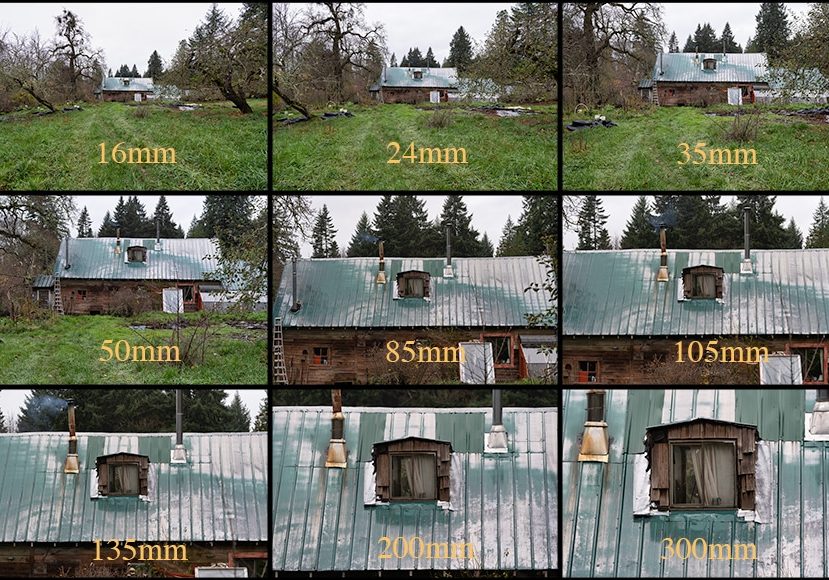
FOV Calculation: Understanding Field of View in Photography
The math behind field of view in photography is a tricky topic, but understanding the concept is pretty simple. This guide breaks it down for you the easy way!
Learn | Photography Guides | By Teryani Riggs
Many things in this world go hand-in hand: cookies and cream, peanut butter and jelly, bagels and salmon… In the photography world, we’ve got field of view and lens focal length.
Ok, these two aren’t quite as tasty and the food combos, but they’re still pretty important!
You see, humans and cameras see quite differently.
Humans have binocular vision, meaning that we see with two eyes, not just one. This allows us to have a fairly wide field of view: 180 degrees, give or take a few degrees of peripheral vision.
Camera lenses, with the exception of some fisheye lenses, see much less than that. Knowing just how much of the world your camera will see is a key factor in choosing which lens to use.
Unsurprisingly, many beginner photographers only think about focal length when they go to purchase a new camera lens. In reality, field of view is actually what’s guiding their decision.
So, what is a field of view exactly? Simply defined, field of view (FOV) in photography is the observable world you can see through your camera at any given moment. It’s usually expressed in terms of degrees, referring to the literal angle of view your lens allows your sensor to see. This is the widely accepted field of view definition in photography.
Why does the field of view matter?
Well, what most of us are doing when buying a lens according to focal length is imagining what field of view it will create. It’s ultimately what determines what kind of lens you’re going to buy.
It’s also useful to know the field of view if you have a limited space to work in and you need to decide which lens to use. Say, for example, you’re shooting portraits in a small garage and want to use a prime lens. Knowing the FOV will help you know exactly what focal length will work for you.
Let’s take a look at just what field of view is, how it relates to lens focal length, and how it ultimately can guide you in knowing which lenses are best for which situations.
What is Focal Length and Field of View?
Contrary to how it might seem, the lens focal length doesn’t refer to how long the lens is.
Rather, it’s the distance from the image plane to the optical center of the lens when the lens is focused at infinity.
(The optical center is where all the light rays converge after passing through the lens elements.)
Put another way, the focal length is simply the distance from the camera sensor to the place where the light rays converge after going through the lens elements.
(How to choose the best focal length for portrait photography.)
One thing to keep in mind is that inside your camera we’re actually working with circular images. Because your sensor is a rectangle, it captures the rectilinear portion of this cone. That rectangle comprises your field of view.

Now the confusing thing is that angle of view and field of view are often used interchangeably, and it’s how most manufacturers refer to field of view, but they’re not quite the same thing.
The angle of view is the angular size of the view cone. (See diagram above.) You might also see it referred to as the angular field of view.
The overall field of view is the maximum area your sensor can capture at a given lens focal length of a lens. It’s the lens focal length combined with the size of your camera’s sensor that determines the camera field of view. It is easy to figure out what is field of view of the camera by knowing the focal length.
So why do manufacturers focus more on lens focal length than field of view?
Well, sensor size isn’t standardized. Not only is a full-frame sensor on a Canon camera likely to be a slightly different size than a sensor on a Nikon FX camera, but even next-generation cameras of the same line can employ different sensor sizes.
How Much Do You REALLY Know About Photography?! 🤔
Test your photography knowledge with this quick quiz!
See how much you really know about photography...

That means the field of view will be different in each case.
Focal length, on the other hand, is the same regardless of sensor size – it will always be the distance from the sensor to the optical sensor. That means a 35mm lens is a 35mm lens no matter who makes it or what camera it’s paired with.
(Here’s how to calculate focal length.)
As a result, it’s much easier for camera manufacturers to reference.
What affects field of view?
The answer is simple: sensor size and lens focal length. Distance from your subject (i.e. “zooming with your feet”) may look like it’s affecting your field of view, but it’s not really changing the angle of view inside your lens.
- Sensor Size
Different camera sensor sizes have innately different fields of view. Smaller sensors will have a narrower FOV. Larger sensors will innately have a wider FOV.
Since 35mm film cameras were the norm back in the day, that’s the visual field all digital cameras are compared to. Full-frame sensors are more-or-less the same size as what was 35mm film.
Smaller sensors capture a smaller portion of the image cone and therefore have a smaller FOV than a full-frame sensor camera. A medium format camera, having a larger sensor, will have a larger FOV than a full-frame.
- Lens Focal Length
If you’re always shooting with the same sensor (i.e. the same camera), then the main thing that will change your field of view is the lens and what lens focal length you choose to use.
The most important thing to remember is that shorter focal lengths have a larger angle of view. Conversely, longer focal lengths will have a narrower angle of view. This holds true for both prime lenses and zoom lenses.
For example, shorter lens focal lengths (i.e. 16mm, 24mm, and 35mm) have a larger angular field of view, hence the term “wide-angle” lens.
These lenses also tend to have a level of distortion that needs to be addressed in post-processing, but they capture a large amount of the scene in front of them.
A “normal” lens is one where the FOV looks natural and is more or less what the human eye would expect from an image – there’s no noticeable expansion or compression. The nifty-fifty (50mm) is considered normal in 35mm (full-frame) photography and an 80mm lens hits the mark for those shooting medium format.
“Long lenses” (including telephotos) have longer focal lengths than either a normal or wide-angle lens, and therefore a narrower angle of view. Telephotos, in particular, have a degree of magnification that makes it easier for a subject to upfill more of the frame.
How is Field of View (FOV) Calculated in Photography?
Field of view is calculated through a bit of simple trigonometry.
Don’t worry if math isn’t your thing. We’re including a field of view chart down below. This section is really more for those who love to geek out on how things work.
Let’s take another look at the lens diagram again:

A closer look shows us that the angle of view is actually the angle between any light captured on the horizontal dimension, and any light captured at the edge. (The red lines mark the edge.)
When the FOV is measured in degrees, like on the manufacturer’s lens specs, they’re referring to the angular field of view in the horizontal dimension – from the right to the left edge of the frame. Vertical FOV is measured from the top to the bottom. Diagonal FOV is measured from corner to opposite corner.
(Most of the time horizontal FOV is all we need to know. The exception is the example given above where you need to shoot in a very confined area. In that case, you may need to know your field of view exactly.)
Using the image above and the magic of trigonometry, we can calculate the overall field of view with the equation below:
Angle of view (in degrees) = 2 ArcTan (sensor width / ( 2 x focal length))) * (180/π)
Note: You only need the (180/π) part if your calculator is working in radians. If yours is working in degrees, leave that part out!
Since this equation has the sensor size as one of the factors, it also covers crop factor. (Remember, the smaller the sensor size, the smaller the FOV.)
We can also go backwards: if you know your field of view and your sensor size, you can figure out what focal length of lens to use. Pretty nifty, no?
This is pretty much all there is to it…with the exception of a few adjustments to be made for the distortion of super wide-angle lenses (fish-eyes) and the magnification factor of macro lenses.
Of course, you won’t ever have to do the math yourself (unless you want to). There are plenty of field of view charts (like the ones below) and online field of view calculators available.
Some of the calculators even allow you to enter in other variables, too, like the camera distance from the subject, the distance from the subject from the background, etc.
So what does all this mean in practical terms? Let’s take a look.
Lens Field of View Comparison
Here’s a field of view sampling of some of the more common focal length lenses we’re likely to be shooting with.
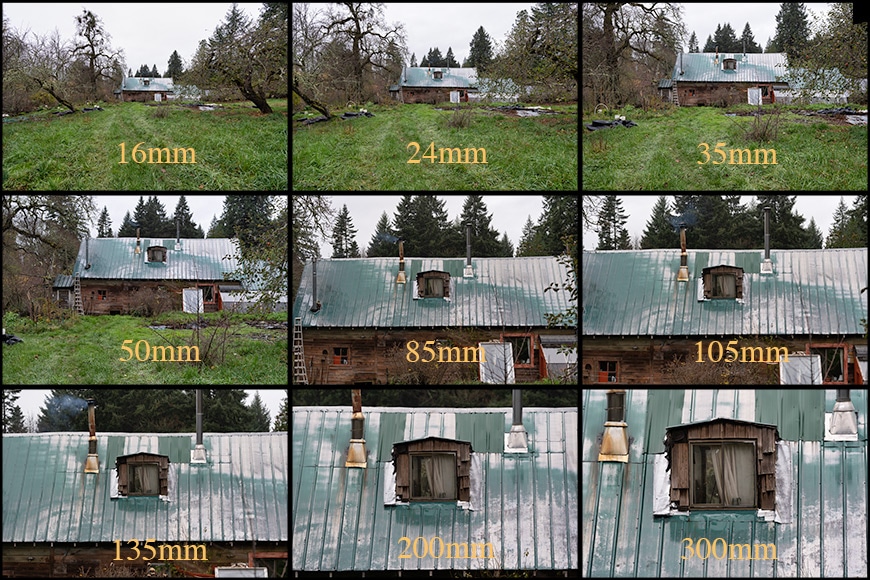
Please note that all of these images were taken on a full-frame camera. Crop-sensor cameras will have a smaller angular field of view using the same focal length.
All of the images above were taken from the same location on a full-frame Sony A7 III. The only thing that changed was the focal length of the lens. Here you can clearly see the differences between the camera FOV.
What lens you’ll need for a given situation really depends on the nature of the image you’re looking to capture.
For example, if you want a lot of the background included in an image, you’ll want to choose a lens with a larger field of view (and a shorter focal length).
The wider lenses like the 16mm or 24mm are used for landscapes, cityscapes, and astrophotography. Photojournalists often favor a 35mm lens – it’s wide enough to capture a fair amount of background yet has less distortion than its wider cousins.
For an image with a “natural” look – one without a lot of distortion or magnification – the FOV offered by a 50mm or even an 85mm lens will do the trick. In fact, 85mm prime lenses are favorites of many portrait photographers.
As we get into the longer lenses the level of compression and magnification goes up as well. A little bit can actually be quite flattering in portraits, which is why 100mm, 105mm, and even up to 135mm can be found in a portrait photographer’s lens collection.
(Many portrait photographers favor prime lenses over zoom lenses, as prime lenses create sharper images.)
To make things that are far away fill your camera’s visual field, choose something with a very narrow field of view. A telephoto lens that hits somewhere in the 200mm or 300mm range will have a nice level of magnification. These are the lenses that wildlife and sports photographers favor.
Field Size
Speaking of magnification, another important concept to understand when looking at field of view is field size or how much of the subject and background are visible in your camera’s field of view.
This is determined by the distance between the camera and the subject and the focal length of the lens. A wider field of view will have a larger field size; a narrower field of view will have a smaller field size.
Wide-angle lenses will expand a perspective, providing a larger field size. Telephoto lenses will compress a perspective, thereby magnifying the subject.
For example, a 200mm lens will enlarge objects 2x more than a 100mm lens does and 4x more than a 50 mm lens does. The field size is the reciprocal, in this case, either 1/2 or 1/4 of the dimension.
If you’re using a 50mm lens and want an object to be 3x larger in the frame, switch to a 150mm lens. Etc.
Lens Angle of View Chart Examples
Here’s a different way of looking at it, this time from the perspective of a crop-sensor camera.
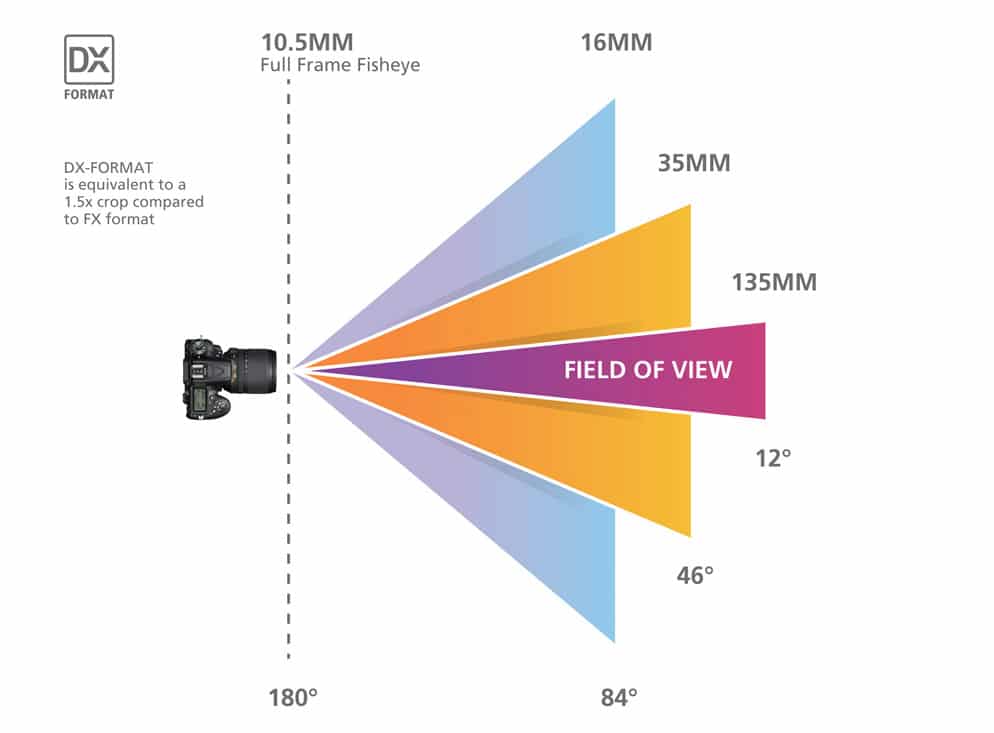
Credit: Nikon USA
Here you can see how the 135mm telephoto lens has the narrowest angular field of view at 12 degrees. A 35mm lens has a considerably larger conical visual field with a 46-degree FOV. A focal length of 16mm in with a FOV of 84 degrees.
If you want to go the whole hog and capture a 180-degree view, you’d need a 10.5mm full-frame fisheye lens. That will, of course, give you plenty of distortion, but some actually like the effect.
Bumping up to a full-frame sensor, you can see that it takes a longer focal length to get the same angular field of view:
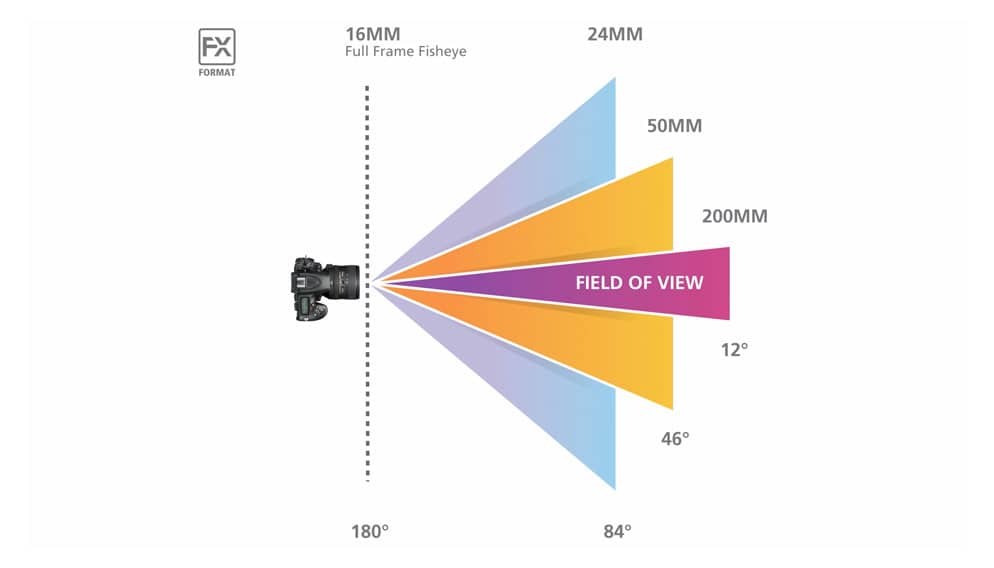
Credit: Nikon USA
On a full-frame camera, a 200mm lens would get a 12-degree FOV, a 50mm lens would come in at 46 degrees, and a 24mm lens would come in at 84 degrees. It would take a 16mm fish-eye to get the full 180-degree horizontal FOV.
For a more definitive quick reference chart, take a look at this one from Nikon, covering FX, DX, and even CX formats:
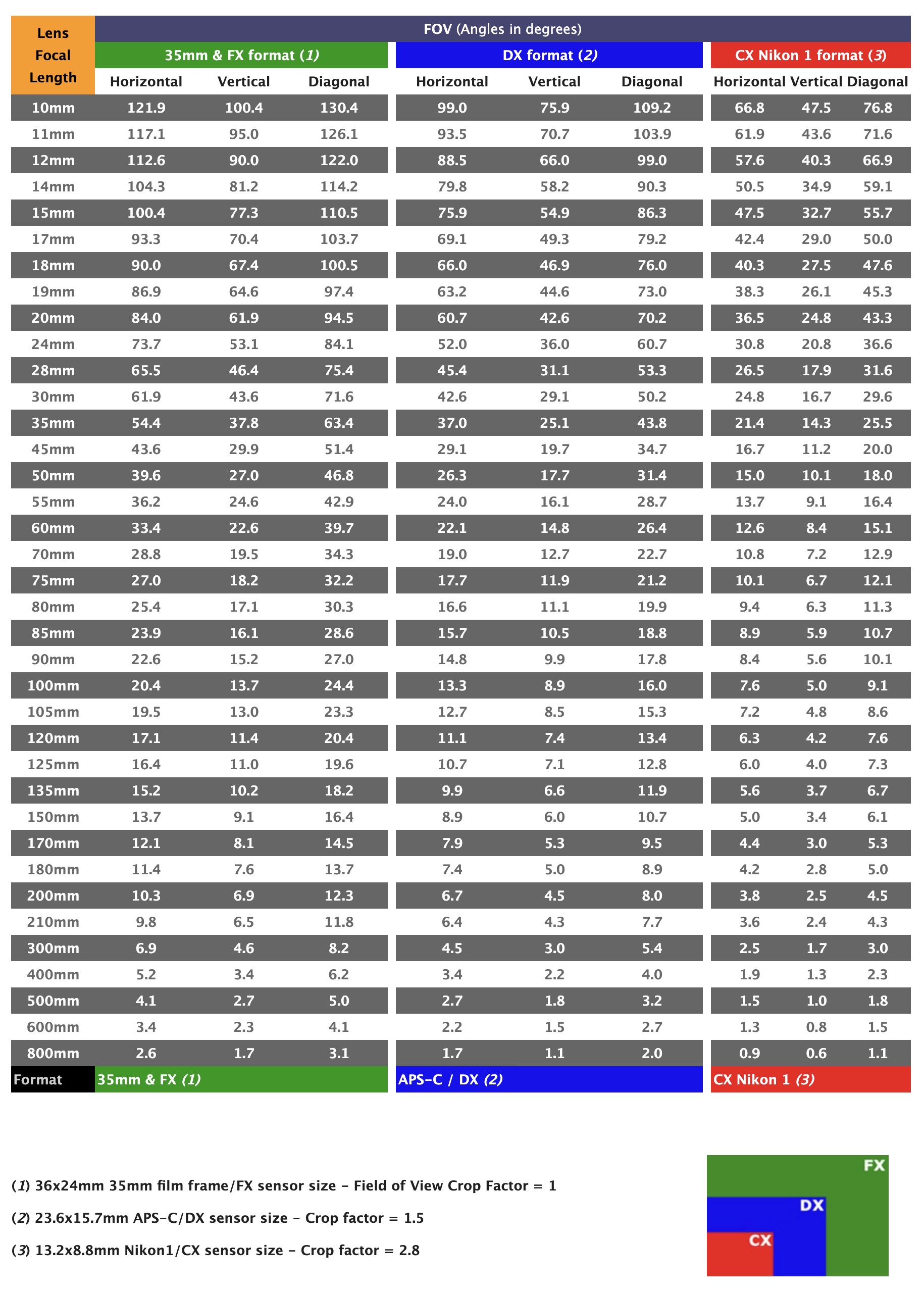
This chart covers the focal lengths of normal, rectilinear camera lenses. Fisheye FOV is a bit different. | Credit: Nikonians (Click to Enlarge)
The chart above will give the field of view of just about any normal (rectilineal) Nikon lens.
Say you want to know field of view of a 35mm lens mounted on an FX body, find the “Lens Focal Length” column and look down to the row marked “35mm” and then over to the green area 35mm & FX-format cameras.
The field of view for a 35mm Nikon lens turns out to have a horizontal FOV of 54.5 degrees, 37.8 degrees of vertical range, and 63.4 degrees diagonally. This is the maximum area your camera can “see.”
For a 50mm lens on an APS-C/DX sensor, the FOV comes out to 26.3 degrees horizontally, 17.7 degrees vertically and 31.4 degrees diagonally.
Remember, not all camera manufacturers use the same sensor size when they refer to “full-frame” or “crop sensor,” so the numbers will usually be slightly different when using other brands.
Field of View FAQs
What is ‘normal’ field of view?
A normal field of view is one that looks totally natural to the human eye. For full-frame cameras, this would be achieved with a 50mm lens.
How do you calculate field of view?
Here’s how to calculate field of view:
FOV = 2 * arctan (S / 2f)
Where S is the size of the sensor (diagonal size in millimeters) and f is the focal length of the lens (also in millimeters).
What field of view is 180?
The only camera lens that can achieve a 180-degree field of view is a super-wide fisheye lens. Be prepared for plenty of distortion, though.
What is the FOV of a 24mm lens?
This will vary depending on the size of your camera sensor, but in general, the field of view of a 24mm lens will be somewhere around 84 degrees for full-frames, and 61 degrees for crop sensors.
Does aperture affect field of view?
In general, aperture does not affect FOV.
Final Words
Bringing all the technical talk down to how field of view affects your photography world, can help you:
- Better understand the visual abilities of any given lens
- Choose which lens fits your style of photography
- Figure out which lens you’ll need to use when you’re shooting in a confined space.
The more experience you get with different lenses and shooting in different environments, the more intuitive the relationship between field of view and lens focal length will become.
Until then, feel free to use the charts above… and don’t forget to have fun!

Check out these 8 essential tools to help you succeed as a professional photographer.
Includes limited-time discounts.
Teryani Riggs (they/them) is an adventure, who loves all things wild and free. Teryani can often be found in the midst of a social/eco-justice campaign, hiking through wild backcountry, or hitchhiking around the world listening to other people’s stories. While their focus has historically centered on landscape, travel, and wilderness photography, they’ve also been hired to shoot genres as varied as historical fiction reenactments in the studio to product and food photography.













